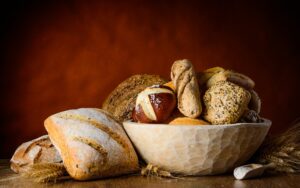WE TRIED TO IDENTIFY THE ORIGIN OF GNOCCHI BY SPINNING AMONG THE ANCIENT RECIPE BOOKS, WHICH BETWEEN THEY OFFER A LOT OF DELICIOUS VARIATIONS, GOING AWAY DISAPPEARING FROM OUR TABLES.
PROMOTION OF OUR HOMEMADE GNOCCHI: https://ristorantedelponte.ch/evento/promo-gnocchi-a-volonta-con-dessert/
Unlike durum wheat pasta, gnocchi are an easy-to-make homemade food, made with a few simple ingredients within the reach of any kitchen.
The various types of dumplings
Perhaps precisely for this reason, many variations of this pasta have followed one another over time, so much so that the gnocchi could not be defined as a format, but a family in its own right. Nowadays in Italy we basically know three categories of gnocchi: those made with potatoes , those made with semolina (also called Roman-style) and the dumplings whose German root of the name – knödel – means “dumpling”. To these we can add Sardinian gnocchetti – malloreddus – which actually have more characteristics in common with semolina pasta. In the past, however, the types were many more and some of these have disappeared from our tables.
The birth of gnocchi
It seems that the first recipes for gnocchi were published for the first time in the second half of the sixteenth century by Cristoforo Messisbugo and Bartolomeo Scappi , two of the greatest chefs of the Renaissance. The “maccaroni called gnocchi” are mixed with flour, breadcrumbs, boiling water and eggs, then passed “on the reverse side of the gratugia” , just as is done with today’s potato gnocchi. Served dry, the sauce is typical of all Renaissance pasta made up of butter, cheese and spices (and a little sugar, to taste).
This type of preparation lasted for several centuries until the beginning of the twentieth century, under different names with slight variations. The most common is to add a good dose of cheese and increase the number of egg yolks, forming a mixture similar to that used for today’s passatelli.

The German dumpling
The same dough described for the “maccaroni” can be enriched with the addition of milk, breadcrumbs, sometimes rice, butter and spices to make the “German-style gnocchi” , ancestors of modern dumplings. They appear initially in the “Modern Apicius” of Francesco Leonardi from 1790, always in the form of small dumplings to be served dry, but after a few decades they will take on the classic size of an egg and will be served in broth, like the “Germanic dumpling” of Antonio Odescalchi of 1834 which includes liver and spleen among the ingredients.
The cream puff gnocchi
At the end of the eighteenth century what will be the most common recipe for gnocchi called “water gnocchi” or “gnocchi bignè” appeared. The dough is almost identical to today’s choux pastry (that of the current cream puffs) and consists of a polenta composed of water (or milk), butter, flour, enriched with whole eggs and a variable number of egg yolks. This pasta was then shaped into small cylinders, lozenges, or by spooning the dough into boiling water waiting for it to swell before draining it and serving it with butter and cheese. There are numerous variations of this recipe that also include spinach or mozzarella, or rice flour to replace wheat flour.
For almost a century this recipe of gnocchi remained the most widespread and is still found almost identical in the early twentieth century as “Light dumplings” (Giulia Lazzari Turco “Practical manual of cooking, pastry and sideboard for family use” of 1904) or as a regional specialty, called “Macaroni alla veneziana” (“100 Italian and foreign cuisine specialties” published by Sognozo in 1908).
One of the oldest recipes of water gnocchi
One of the oldest recipes of water gnocchi is reported by Francesco Leonardi in his “Modern Apicius” of 1790: “Boil in a cazzarola (pot) a little water with a good piece of butter, and salt, add enough flour to make a manageable pasta like the Reale one (which included 22.8 cl of water, 56 grams of butter and an unspecified amount of flour), cook it well over the fire, always moving it with a wooden spoon, then put it in another casserole dish. When it is cold, place it at a time for each pound (340 g) of flour three raw egg yolks and a white one, always handling the eggs so they incorporate them with the dough, add a handful of grated Parmesan cheese. Place the dough on the pastry table, roll it out little by little with your hands with almost no flour, to the size of a big finger, cut the gnocchi into mostaccioletti (small lozenges) , cook them in the right boiling water with salt, when they become swollen, and inside spongy (spongy) they will be cooked; remove them immediately, drain them. “
Once ready they are arranged in layers in a baking dish with butter, a little cream and Parmesan, before being baked. At your discretion you can add cinnamon, nutmeg or pepper.

The potato gnocchi
Although the potato has been known and described by agronomists since the late Renaissance, it is necessary to wait for the dramatic results of the famine of 1764 to have recipe books that recommend its consumption mixed with flour, in the form of bread or pasta. The first solution never took hold due to the consistency of the potato bread that melted when wet, so it could not be used as a base for soups, one of the key foods of the gastronomy of the time. The introduction of the boiled potato inside the gnocchi was instead quite successful, but still at the beginning of the twentieth century this recipe was only one of the many variations present in the kitchen.
The first recipes of potato gnocchi
The first recipes of potato gnocchi are proposed at the end of the eighteenth century and the boiled and mashed potatoes are not simply mixed with flour, but inserted into the composition of the water-based gnocchi (see above). For decades, various other ingredients were added to the potato gnocchi, such as egg yolks, cream, parsley, garlic, ricotta and veal fat. Pellegrino Artusi in 1891 describes two recipes: the first with boiled and mashed potatoes mixed with minced chicken breast, parmesan, egg yolks, flour and nutmeg. And the second, much simpler, with just potatoes and flour.
This minimalist version, destined to have great fortune, appears as early as 1871 under the name of “Gnocchi alla marchigiana” , but in 1908 the first recipe book of traditional Italian cuisine includes them under the Bolognese specialties, while the “Talisman of happiness” of 1927 speaks of it as a typical dish of Roman trattorias which is served on Thursdays.

gnocchi alla Romana
But the gnocchi alla romana we know today are very different and their particularity is that they are made from a polenta which, once cooled and cut into pieces, is not boiled in water, but passed directly in the oven with butter and cheese. It seems that they appear for the first time in “Il nuovo cuoco Ticinese” of 1846, a recipe book not exactly from Lazio, but which must have enjoyed an unusually broad point of view thanks to its geographical position.
This first version was made up of flour, milk, egg yolks perfumed with grated lemon peel. With slight differences (the eggs are whole, the lemon disappears and the gruyere comes in) it is still found at the beginning of the twentieth century. The semolina will replace the common flour only in the 1930s, setting the recipe that we all know today. For the record, in the recipe books another type of gnocco alla romana based on potatoes and chicken breast to be served in broth is mentioned, substantially identical to that described by Pellegrino Artusi at the end of the nineteenth century.
The gnocchi dispersed
The surviving gnocchi today are a fraction of those recorded in recipe books over the centuries which have been lost in memory. There were the “golden gnocchi” made with corn flour, those “alla dama” mixed with cooked egg yolks, rice, chickpea, pea gnocchi with cream and many others. Among recipes and variants, only the “Practical manual of cooking, pastry and sideboard for family use” by Giulia Lazzari Turco mentions at least 30 types to be served in broth and 24 to be served dry: a wealth of specialties from which to draw on full hands for those wishing to experience authentic, yet unusual, traditional Italian cuisine.
source: https://www.gamberorosso.it



